EXHIBIT 99.1
Published on September 14, 2020
Exhibit 99.1

NASDAQ: EYEG Corporate Presentation September 2020

TB D 2 Some of the matters discussed in this presentation contain forward - looking statements that involve significant risks and uncertainties, including statements relating to the prospects for the Company’s OBG and EGP - 437 product candidates, for the timing and outcome of the Company’s clinical trials, the potential approval to market OBG and EGP - 437 , and the Company’s capital needs . Actual events could differ materially from those projected in this presentation and the Company cautions investors not to rely on the forward - looking statements contained in, or made in connection with, the presentation . Among other things, the Company’s clinical trials may be delayed or may eventually be unsuccessful . The Company may consume more cash than it currently anticipates and faster than projected . Competitive products may reduce or eliminate the commercial opportunities of the Company’s product candidates . If the U . S . Food and Drug Administration or foreign regulatory agencies determine that the Company’s product candidates do not meet safety or efficacy endpoints in clinical evaluations, they will not receive regulatory approval and the Company will not be able to market them . Operating expense and cash flow projections involve a high degree of uncertainty, including variances in future spending rate due to changes in corporate priorities, the timing and outcomes of clinical trials, regulatory and developments and the impact on expenditures and available capital from licensing and strategic collaboration opportunities . If the Company is unable to raise additional capital when required or on acceptable terms, it may have to significantly alter, delay, scale back or discontinue operations . Additional risks and uncertainties relating to the Company and its business can be found in the “Risk Factors” section of the Company’s Annual Report on Form 10 - K filed with the SEC on March 04 , 2020 . The Company undertakes no duty or obligation to update any forward - looking statements contained in this presentation as a result of new information, future events or changes in the Company’s expectations, except as required by applicable law . The Company uses its website ( www . EyeGatePharma . com ), Facebook page ( https : //www . facebook . com/ EyeGatePharma / ), corporate Twitter account ( https : //twitter . com/EyeGatePharma ), and LinkedIn page ( https : //www . linkedin . com/company/ 135892 / ) as channels of distribution of information about the Company and its product candidates . Such information may be deemed material information, and the Company may use these channels to comply with its disclosure obligations under Regulation FD . Therefore, investors should monitor the Company’s website and its social media accounts in addition to following its press releases, SEC filings, public conference calls, and webcasts . The social media channels that the Company intends to use as a means of disclosing the information described above may be updated from time to time as listed on the Company’s investor relations website . Forward Looking Statements

TB D 3 EyeGate Pharma: Company Highlights Clinical - stage ophthalmology company focused on developing products for the treatment of ocular disorders Main platform and intellectual property is based on modifying hyaluronic acid (“HA”) Lead product from the platform is the Ocular Bandage Gel (“OBG”) eye drop First combination product from the platform is MoxiGel (OBG + antibiotic) EyeGate recently completed clinical development for OBG’s first indication (corneal wound healing) and is preparing to initiate a pivotal study for the second indication (punctate epitheliopathies – dry eye). EYEG NASDAQ listed 2015 IPO

OBG Eye Drop: A Therapeutic Lubricant 4 OBG is a preservative - free eye drop that promotes corneal health by providing a protective barrier on the ocular surface. Key ingredient is a crosslinked or chemically modified version of hyaluronic acid (“HA”) • HA is a natural substance found in the body, predominately in skin and joints • HA is a highly viscous lubricant Crosslinking HA provides ideal characteristics for an eye drop • Extends product contact on the ocular surface from ~15 minutes to ~2 hours • Prevents product degradation, maintaining protective barrier that promotes wound healing • Shear - thinning properties mitigate blurriness and allow higher - concentration of product 1. As a stand - alone device AND 2. In combination with pharmaceutical ingredients (e.g. antibiotic and anti - inflammatories) OBG Development Franchise

TB D 5 Product Category Indication Pre - Clinical Pilot / Phase 2 Pivotal / Phase 3 FDA Filing Commercial OBG Wound Healing Post PRK Surgery Punctate Epitheliopathies Moderate / Severe Dry Eye MoxiGel Infectious Disease Bacterial Conjunctivitis Clinical Development Completed Moving into Pivotal Study IND Product Development Pipeline ▪ PRK, a surgical procedure, is ideal for clinical development ▪ Large uniform wound (9mm) on a homogenous population OBG – Wound Healing OBG – Epitheliopathies MoxiGel – Infectious Disease Prevention vs. Treatment ▪ Bacterial conjunctivitis is an ideal indication for demonstrating treatment or eradication of bacteria ▪ Although all wounds are prescribed an antibiotic, demonstrating prevention requires very large studies ▪ Dry eye, a chronic condition, is ideal for clinical development ▪ Easy to enroll and market opportunity is large

TB D 6 Product Indication 2020 2021 2H 1H 2H OBG Wound Healing Post - PRK File de novo Application de novo Clearance & Launch Preparation Punctate Epitheliopathies (Moderate / Severe Dry Eye) File IDE Pivotal Study First Patient In & Study Execution Top - line Data & File de novo Application MoxiGel Bacterial Conjunctivitis File IND First Patient In & Study Execution ▪ De Novo clearance for wound healing is anticipated at the same time as top - line data for the punctate epitheliopathies pivotal s tudy ▪ Confirmed with FDA that the MoxiGel phase 2 study can qualify for one of the two required registrational studies for bacteria l c onjunctivitis Key Development Milestones

TB D 7 OBG Stand - Alone Device Market Opportunity There are over 50 million potential patients with corneal wounds or epitheliopathies in the United States. Source: American Academy of Ophthalmology (https://www.aao.org/newsroom/eye - health - statistics) OBG drops are being developed to address ophthalmic conditions where epithelial cells are either missing (wounds) or compromised (epitheliopathies) and patients would benefit from accelerated healing and added lubrication. Epitheliopathies : Dry Eye ~18 million US patients ▪ Episodic / mild ▪ Moderate ▪ Severe Epitheliopathies : Non - Dry Eye ~28 million US patients ▪ Contact lens wear ▪ Ocular irritants ▪ Glaucoma medications ~5 million US patients ▪ Refractive surgeries (e.g. PRK) ▪ Cataracts ▪ Collagen cross - linking Wounds : Surgery Wounds : Trauma ~2 million US patients ▪ Injuries / abrasions ▪ Chemical burns ▪ Difficult to heal (PCED/ulcers) OBG Market Opportunity Percentages 35% 53% 3% 9%

TB D 8 OBG Combination Product (MoxiGel) Market Opportunity 1 IMS Health (Division of IQVIA) MoxiGel has the potential to become the first eye drop that both accelerates healing and includes an antibiotic. Antibiotic eye drops are widely prescribed to help treat the following: ▪ Conjunctivitis ▪ Wounds ▪ Post - surgery recovery ▪ Cataract surgery ▪ Photorefractive Keratectomy (PRK) ▪ Laser - assisted in - situ Keratomileusis (LASIK) prescriptions are written for antibiotic eyedrops annually in the United States 1 16 million Bacterial Conjunctivitis Primary signs are discharge and redness

TB D 9 OBG Commercialization Strategy • Wound healing at ~$100 per 5mL fill (one - time use) • PE (dry eye) at ~$140 per 10mL fill (monthly supply) Anticipated Net Selling Price per unit • Scale - up: completing increase from 40L to 200L batch size • Packaging: FDA agreed on use of multi - dose preservative - free bottle Cost of Goods Sold (COGS) – Objective is 90% gross margin • Go - to - market strategy underway for in - house commercialization • Customer is a small group of specialists that perform the surgery • Stepping - stone to launch second indication — dry eye — a much larger market with broader group of eye - care professionals Anticipate launch for first indication — wound healing in patients that have undergone PRK surgery — first half 2022 • Approximately 850,000 corneal refractive surgeries per year 1 • Approximately 9 million patients with moderate and severe dry eye 2 U.S. population being treated for developed indications 1 American Academy of Ophthalmology ( https://www.aao.org/newsroom/eye - health - statistics ) and Ocular Surgery News: April 10, 2019 Issue 2 Global Data. Dry Eye Syndrome Drug Forecast and Market Analysis to 2026. Published June 2018. Year 2020 data.

10 OBG: Wound Healing in patients who have undergone PRK surgery

TB D 11 Refractive Market Opportunity for Wound Healing What Is PRK? • PRK is a surgical correction of refractive errors for patients who are not suitable candidates for LASIK due to: o Inadequate corneal thickness o Larger pupil size o Dry eye o Anterior basement membrane disease • PRK involves controlled mechanical removal of corneal epithelium with subsequent lasering of stroma What Is The Unmet Need? • While PRK yields superior visual results, complications include: o Post - operative pain o Risk of infection o Corneal haze o Decreased contrast sensitivity o Slower visual recovery • Standard - of - care is a Bandage Contact Lens (BCL), which can result in subsequent erosion of epithelium What Is The Opportunity? • Enabling the epithelium to heal faster may mitigate peri - operative complications and improve long - term visual outcomes • The PRK population is ideal for clinical development: o Large population (~850,000 LASIK/PRK surgeries per year in the U.S.) 1 o Large wound (9mm), same size for all patients and know time zero o Healthy eyes required and time to healing well - established 1 American Academy of Ophthalmology (https://www.aao.org/newsroom/eye - health - statistics) and Ocular Surgery News: April 10, 2019 Issue

TB D 12 Pivotal Study Design Enrolled patients undergoing PRK surgery (N=250) Day 0 PRK Surgery Week 2 Post - surgery Follow - up Measure differences in outcomes Screening (n=234) OBG (crosslinked HA eye drop) Standard - of - care (bandage contact lens) Randomize Day 2 Fluorescein Stain Day 3 F luorescein Stain 1 ° Endpoint Day 4 F luorescein Stain Study Design Two - arm, randomized, positive - controlled, masked via reading center Outcome Measures Primary Endpoint: • Complete corneal re - epithelialization on Day 3 (% of eyes with fully closed wound and remain closed) • Wound closure measured by staining of wound; photo of stained wound is sent to reading center Secondary Endpoints: • Time to corneal re - epithelialization at Days 2, 3, and 4 post surgery (eyes are stained with fluorescein and photos are sent to reading center) • Patient is followed for 2 weeks post - surgery Enrollment 250 patients enrolled (9 US sites) with 234 qualified patients randomized to OBG or BCL group post - surgery (16 screen failures) Primary Objective : assess the effect of Ocular Bandage Gel (OBG) vs. a Bandage Contact Lens (BCL) in subjects who have undergone bilateral photorefractive keratectomy (PRK) ClinicalTrials.gov Identifier: NCT03938883 ( https://clinicaltrials.gov/ct2/show/NCT03938883 )

TB D 13 PRIMARY ENDPOINT Percentage healed at day 3 in each group without a recurrent erosion RECURRENT EROSION Only 1 (0.9%) study eye in the OBG group had a recurrent erosion; there were 4 (3.5%) in the BCL group DAY 3 RESULTS At day 3, 79% of study eyes receiving OBG were completely healed compared with 63% in the BCL group Percent Of Patients With Complete Re - Epithelialization (p - value 0.0068) OBG Demonstrated Superiority Versus BCL In Pivotal Study BCL: bandage contact lens 79% 94% 63% 84% 60% 65% 70% 75% 80% 85% 90% 95% 100% Day 3 Day 4 OBG OBG BCL BCL

TB D 14 Wound Size On Average Was 46% Smaller For OBG Patients On Day 2 3.6 0.2 0.1 6.7 1.1 0.3 0.0 1.0 2.0 3.0 4.0 5.0 6.0 7.0 Day 2 Day 3 Day 4 Wound Size - Both Eyes (mm 2 ) DAY 2 WOUND SIZE Average wound size in the OBG arm was half that of the control arm (3.6mm 2 vs. 6.7mm 2 , respectively) The maximum wound size in the OBG arm was approximately one - third that of the control arm (19.9mm 2 vs. 58.1mm 2 , respectively) OBG Demonstrates Dramatic Decrease In Wound Size On Day 2 BCL: bandage contact lens OBG BCL

15 OBG: Punctate Epitheliopathies in patients who have moderate and severe dry eye

TB D 16 What Is Punctate Epitheliopathy? ▪ Punctates are a sign of epithelial compromise (corneal barrier disruption) and is characterized by a breakdown of the epithelium of the cornea and an increased permeability to fluorescein dye ▪ Corneal barrier disruption is associated with an increased risk of corneal ulceration, corneal haze and decreased vision ▪ Corneal permeability to fluorescein dye is used to clinically evaluate severity of corneal barrier disruption What Is The Opportunity? ▪ PE is associated with many pathologic ocular inflammatory conditions, which can include: dry eye, conjunctivitis, trauma/corneal abrasions, contact lens wear, and chemical irritation and burns ▪ No eye drop is currently approved for the treatment of PE in the U.S. Punctate Epitheliopathies

TB D 17 Mild Moderate Severe Total 9.0M 7.6M 1.4M 18.0M 50% 42% 8% 100% Major Opportunity In The Dry Eye Patient Population 1 Global Data. Dry Eye Syndrome Drug Forecast and Market Analysis to 2026. Published June 2018. Year 2020 data. Mild Patient Population Mild population does not require healing of the ocular surface (lubrication only) Moderate to Severe Patient Population ▪ OBG clinical studies target the moderate and severe population (50% of the market), both of which require healing of the ocular surface and lubrication ▪ The moderate population is underserved and provides a significant market opportunity; only 17% are actively taking Rx anti - inflammatory drops and 34% are using lubricants ▪ The severe population has more inflammation resulting in 63% actively taking Rx anti - inflammatory drops and 67 % are taking lubricant eye drops Approximately 18 million patients are diagnosed with dry eye in the U.S. 1 OBG benefits both moderate and severe dry eye populations by accelerating the healing of the ocular surface while providing lubrication.

TB D 18 Pilot Study Design Day 0 Measure differences in outcomes Screening (n= 40 eyes) OBG (crosslinked HA eye drop) Standard - of - care (Refresh® Plus Preservative - Free Lubricant) Randomize Day 7 Fluorescein Stain 1 ° Endpoint Study Design • Two - arm, randomized, positive - controlled, investigator - masked • Seven - day run - in period followed by a fourteen - day treatment period • Patient acted as own control; one eye randomized to OBG arm and one eye randomized to RPF Outcome Measures Primary Endpoint: • Change in NEI corneal fluorescein staining score on Day 14 from baseline for central region and total region of the cornea Secondary Endpoints: • Blurriness: Change in tear film stability and visual acuity at 30 and 60 minutes post instilling drops Enrollment • 20 patients (40 eyes) where both eyes had to qualify for study randomization • Subset analysis completed on 16 patients (32 eyes) – applying additional criteria (central staining) Primary Objective : to evaluate the effect of Ocular Bandage Gel (OBG) vs. Refresh® Plus Preservative - Free Lubricant (RPF) in patients with punctate epitheliopathies (PE) due to dry eye. ClinicalTrials.gov Identifier: NCT04055324 ( https://clinicaltrials.gov/ct2/show/NCT04055324 ) Day - 7 Run - in period Day 14 Fluorescein Stain 1 ° Endpoint
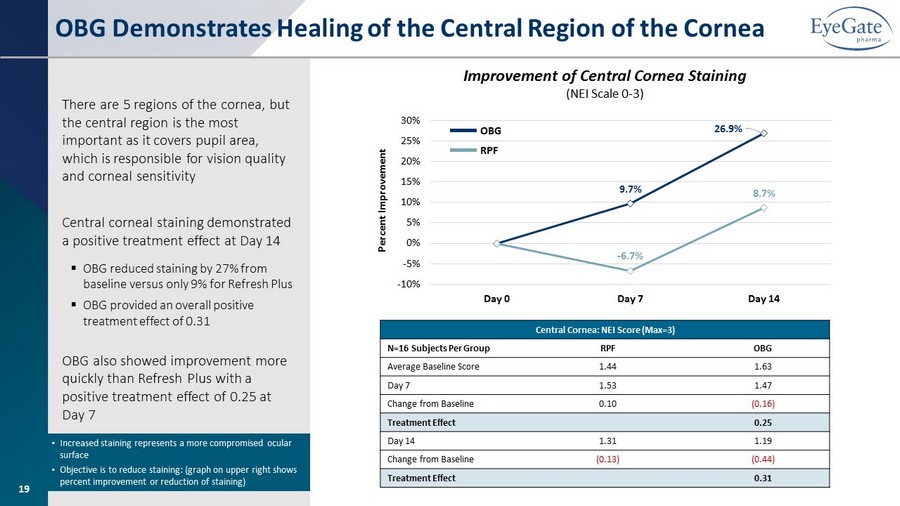
TB D 19 Improvement of Central Cornea Staining (NEI Scale 0 - 3) OBG Demonstrates Healing of the Central Region of the Cornea Central Cornea: NEI Score (Max=3) N=16 Subjects Per Group RPF OBG Average Baseline Score 1.44 1.63 Day 7 1.53 1.47 Change from Baseline 0.10 (0.16) Treatment Effect 0.25 Day 14 1.31 1.19 Change from Baseline (0.13) (0.44) Treatment Effect 0.31 There are 5 regions of the cornea, but the central region is the most important as it covers pupil area, which is responsible for vision quality and corneal sensitivity Central corneal staining demonstrated a positive treatment effect at Day 14 ▪ OBG reduced staining by 27% from baseline versus only 9% for Refresh Plus ▪ OBG provided an overall positive treatment effect of 0.31 OBG also showed improvement more quickly than Refresh Plus with a positive treatment effect of 0.25 at Day 7 9.7% 26.9% - 6.7% 8.7% -10% -5% 0% 5% 10% 15% 20% 25% 30% Day 0 Day 7 Day 14 Percent Improvement OBG RPF • Increased staining represents a more compromised ocular surface • Objective is to reduce staining: (graph on upper right shows percent improvement or reduction of staining)
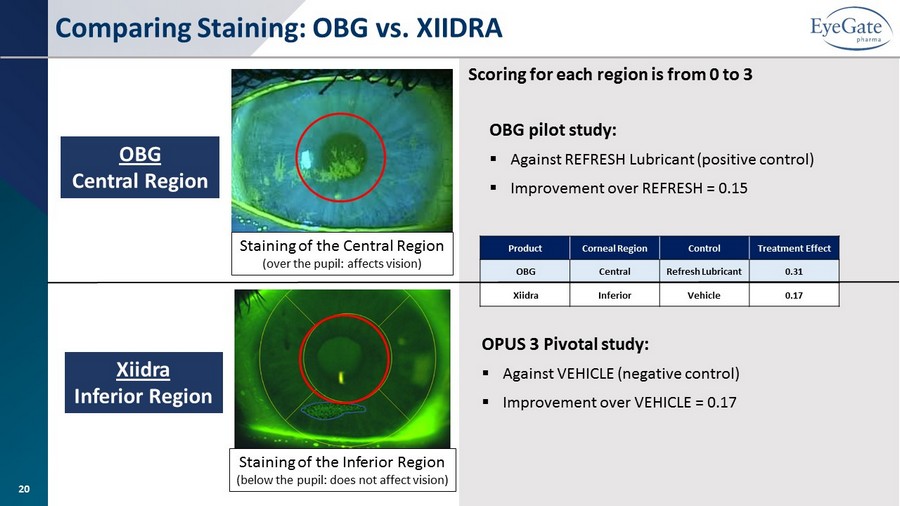
TB D 20 OBG Central Region Xiidra Inferior Region Staining of the Inferior Region (below the pupil: does not affect vision) Staining of the Central Region (over the pupil: affects vision) Product Corneal Region Control Treatment Effect OBG Central Refresh Lubricant 0.31 Xiidra Inferior Vehicle 0.17 OBG pilot study: ▪ Against REFRESH Lubricant (positive control) ▪ Improvement over REFRESH = 0.15 OPUS 3 Pivotal study: ▪ Against VEHICLE (negative control) ▪ Improvement over VEHICLE = 0.17 Scoring for each region is from 0 to 3 Comparing Staining: OBG vs. XIIDRA

TB D 21 VBUT: Vision Break - up Time; Using a HD Analyzer, it is a non - invasive method to determine Tear - Film Stability or Break - up Time BCVA: Best Corrected Visual Acuity First clinical evidence demonstrating that OBG does not cause blurriness while residing on the ocular surface A positive VBUT indicates OBG is still on the ocular surface The BCVA data validates that despite OBG’s high - viscosity, there is no blurriness while OBG is on the ocular surface Clinical Data Supporting Tear - Film Stability Without Blurriness VBUT (seconds) RPF OBG 0 minutes 3.33 4.04 30 minutes 3.33 4.92 Change from 0 minutes 0.00 0.88 Treatment Effect 0.88 N = 4 per group 60 minutes 2.54 4.50 Change from 0 minutes (0.79) 0.46 Treatment Effect 1.25 BCVA (letters) RPF OBG 0 minutes 79.69 84.15 30 minutes 78.93 83.81 Change from 0 minutes (0.76) (0.34) Treatment Effect 0.42 N = 20 per group 60 minutes 79.43 84.31 Change from 0 minutes (0.26) 0.16 Treatment Effect 0.42 Vision Break - Up Time (seconds): Post - Instillation 16% 8% 0% - 20% -25% -20% -15% -10% -5% 0% 5% 10% 15% 20% 0 Minutes 30 Minutes 60 Minutes Percent Change BCVA: Change Post - Instillation (ETDRS Letters Read) - 0.4% 0.2% - 1.0% - 0.3% -2.0% -1.5% -1.0% -0.5% 0.0% 0.5% 1.0% 0 Minutes 30 Minutes 60 Minutes Percent Change OBG RPF OBG RPF

TB D 22 Pivotal Study Design Day 0 Measure differences in outcomes Run - in period (n=376 for randomization) OBG (crosslinked HA eye drop) Standard - of - care (Refresh® Plus Preservative - Free Lubricant) Randomize Day 7 Fluorescein Stain 1 ° Endpoint Study Design • Two - arm, randomized, positive - controlled, double - masked • Seven - day run - in period followed by a fourteen - day treatment period • Main inclusion criteria: corneal staining, tear - film breakup - time and symptomology Outcome Measures Primary Endpoint: • Change in NEI corneal fluorescein staining score on Day 14 from baseline for central region of the cornea • Powered at 90% for demonstrating superiority over control Secondary Endpoint: • Change in NEI corneal fluorescein staining score on Day 14 from baseline for total cornea Enrollment • 376 patients to be randomized post 7 - day run - in period Primary Objective : to evaluate the effect of Ocular Bandage Gel (OBG) vs Refresh® Plus Preservative - Free Lubricant (RPF) in patients with punctate epitheliopathies (PE) due to dry eye. ClinicalTrials.gov Identifier: NCT03938883 ( https://clinicaltrials.gov/ct2/show/NCT03938883 ) Day - 7 Run - in period Day 14 Fluorescein Stain 1 ° Endpoint
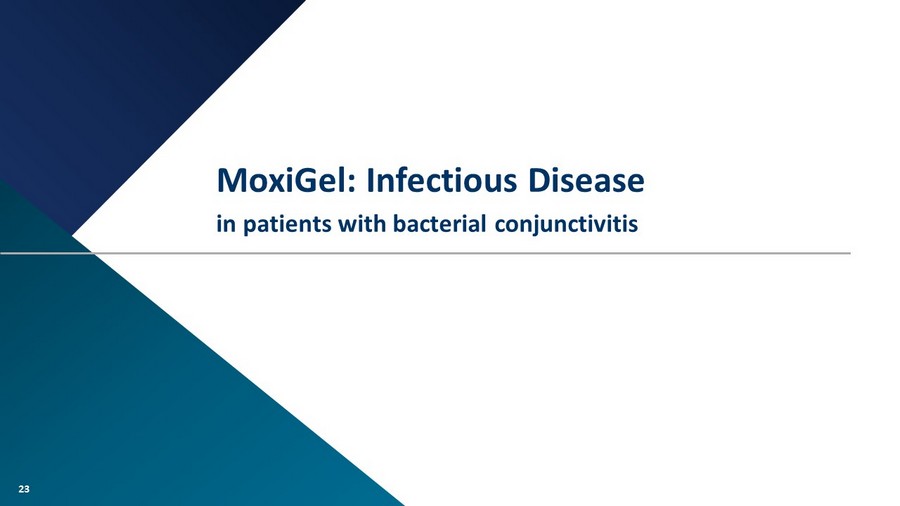
23 MoxiGel: Infectious Disease in patients with bacterial conjunctivitis
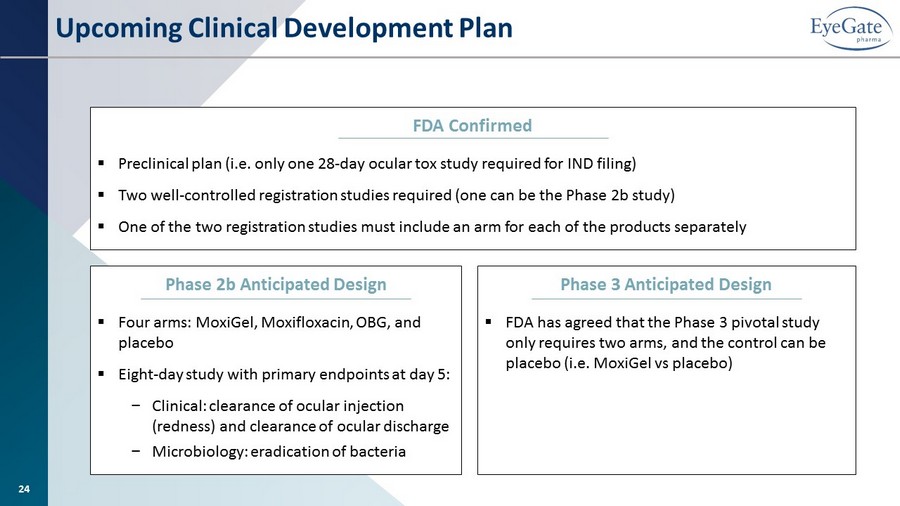
TB D 24 Upcoming Clinical Development Plan FDA Confirmed ▪ Preclinical plan (i.e. only one 28 - day ocular tox study required for IND filing) ▪ Two well - controlled registration studies required (one can be the Phase 2b study) ▪ One of the two registration studies must include an arm for each of the products separately Phase 2b Anticipated Design ▪ Four arms: MoxiGel, Moxifloxacin, OBG, and placebo ▪ Eight - day study with primary endpoints at day 5: − Clinical: clearance of ocular injection (redness) and clearance of ocular discharge − Microbiology: eradication of bacteria Phase 3 Anticipated Design ▪ FDA has agreed that the Phase 3 pivotal study only requires two arms, and the control can be placebo (i.e. MoxiGel vs placebo)
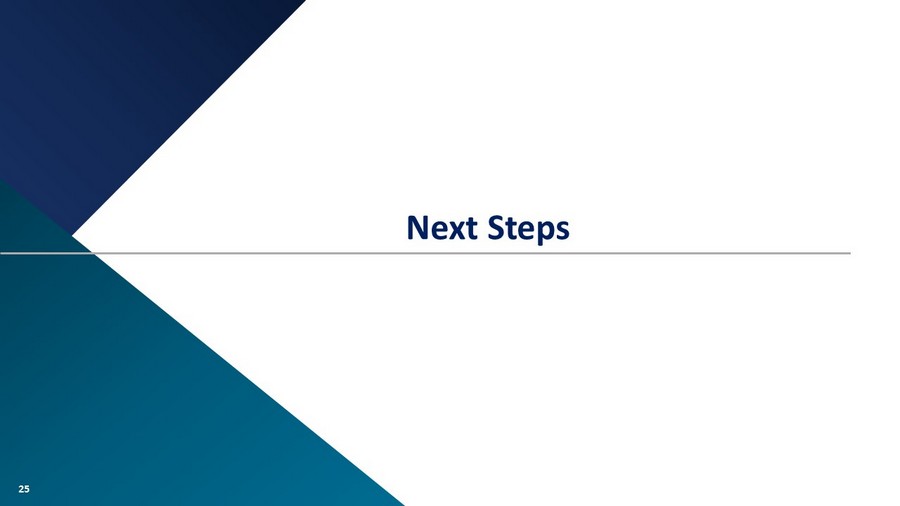
25 Next Steps
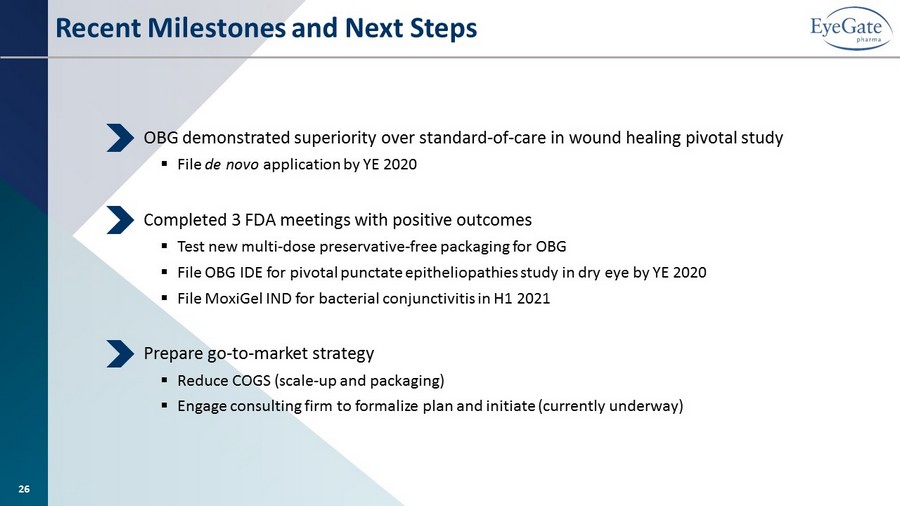
TB D 26 OBG demonstrated superiority over standard - of - care in wound healing pivotal study ▪ File de novo application by YE 2020 Completed 3 FDA meetings with positive outcomes ▪ Test new multi - dose preservative - free packaging for OBG ▪ File OBG IDE for pivotal punctate epitheliopathies study in dry eye by YE 2020 ▪ File MoxiGel IND for bacterial conjunctivitis in H1 2021 Prepare go - to - market strategy ▪ Reduce COGS (scale - up and packaging) ▪ Engage consulting firm to formalize plan and initiate (currently underway) Recent Milestones and Next Steps
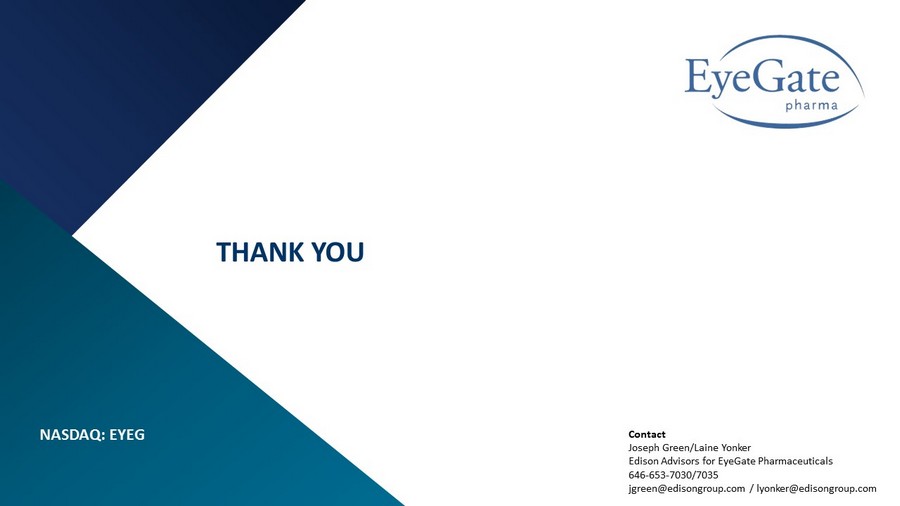
NASDAQ: EYEG THANK YOU Contact Joseph Green/Laine Yonker Edison Advisors for EyeGate Pharmaceuticals 646 - 653 - 7030/7035 jgreen@edisongroup.com / lyonker@edisongroup.com